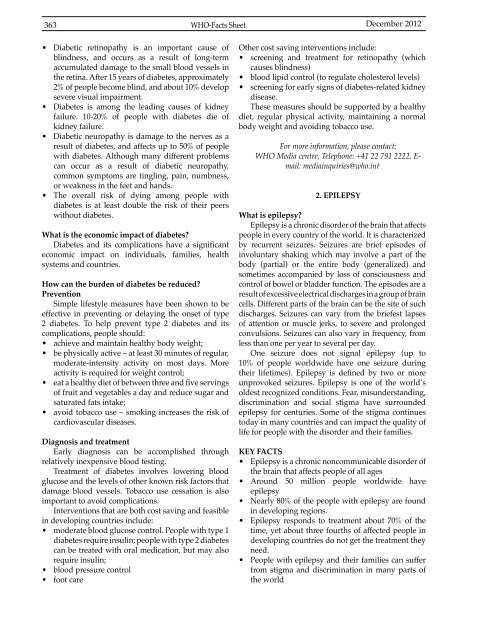Vol 44 # 4 December 2012 - Kma.org.kw
Vol 44 # 4 December 2012 - Kma.org.kw
Vol 44 # 4 December 2012 - Kma.org.kw
You also want an ePaper? Increase the reach of your titles
YUMPU automatically turns print PDFs into web optimized ePapers that Google loves.
363<br />
WHO-Facts Sheet <strong>December</strong> <strong>2012</strong><br />
• Diabetic retinopathy is an important cause of<br />
blindness, and occurs as a result of long-term<br />
accumulated damage to the small blood vessels in<br />
the retina. After 15 years of diabetes, approximately<br />
2% of people become blind, and about 10% develop<br />
severe visual impairment.<br />
• Diabetes is among the leading causes of kidney<br />
failure. 10-20% of people with diabetes die of<br />
kidney failure.<br />
• Diabetic neuropathy is damage to the nerves as a<br />
result of diabetes, and affects up to 50% of people<br />
with diabetes. Although many different problems<br />
can occur as a result of diabetic neuropathy,<br />
common symptoms are tingling, pain, numbness,<br />
or weakness in the feet and hands.<br />
• The overall risk of dying among people with<br />
diabetes is at least double the risk of their peers<br />
without diabetes.<br />
What is the economic impact of diabetes?<br />
Diabetes and its complications have a significant<br />
economic impact on individuals, families, health<br />
systems and countries.<br />
How can the burden of diabetes be reduced?<br />
Prevention<br />
Simple lifestyle measures have been shown to be<br />
effective in preventing or delaying the onset of type<br />
2 diabetes. To help prevent type 2 diabetes and its<br />
complications, people should:<br />
• achieve and maintain healthy body weight;<br />
• be physically active – at least 30 minutes of regular,<br />
moderate-intensity activity on most days. More<br />
activity is required for weight control;<br />
• eat a healthy diet of between three and five servings<br />
of fruit and vegetables a day and reduce sugar and<br />
saturated fats intake;<br />
• avoid tobacco use – smoking increases the risk of<br />
cardiovascular diseases.<br />
Diagnosis and treatment<br />
Early diagnosis can be accomplished through<br />
relatively inexpensive blood testing.<br />
Treatment of diabetes involves lowering blood<br />
glucose and the levels of other known risk factors that<br />
damage blood vessels. Tobacco use cessation is also<br />
important to avoid complications.<br />
Interventions that are both cost saving and feasible<br />
in developing countries include:<br />
• moderate blood glucose control. People with type 1<br />
diabetes require insulin; people with type 2 diabetes<br />
can be treated with oral medication, but may also<br />
require insulin;<br />
• blood pressure control<br />
• foot care<br />
Other cost saving interventions include:<br />
• screening and treatment for retinopathy (which<br />
causes blindness)<br />
• blood lipid control (to regulate cholesterol levels)<br />
• screening for early signs of diabetes-related kidney<br />
disease.<br />
These measures should be supported by a healthy<br />
diet, regular physical activity, maintaining a normal<br />
body weight and avoiding tobacco use.<br />
For more information, please contact:<br />
WHO Media centre, Telephone: +41 22 791 2222. E-<br />
mail: mediainquiries@who.int<br />
2. EPILEPSY<br />
What is epilepsy?<br />
Epilepsy is a chronic disorder of the brain that affects<br />
people in every country of the world. It is characterized<br />
by recurrent seizures. Seizures are brief episodes of<br />
involuntary shaking which may involve a part of the<br />
body (partial) or the entire body (generalized) and<br />
sometimes accompanied by loss of consciousness and<br />
control of bowel or bladder function. The episodes are a<br />
result of excessive electrical discharges in a group of brain<br />
cells. Different parts of the brain can be the site of such<br />
discharges. Seizures can vary from the briefest lapses<br />
of attention or muscle jerks, to severe and prolonged<br />
convulsions. Seizures can also vary in frequency, from<br />
less than one per year to several per day.<br />
One seizure does not signal epilepsy (up to<br />
10% of people worldwide have one seizure during<br />
their lifetimes). Epilepsy is defined by two or more<br />
unprovoked seizures. Epilepsy is one of the world’s<br />
oldest recognized conditions. Fear, misunderstanding,<br />
discrimination and social stigma have surrounded<br />
epilepsy for centuries. Some of the stigma continues<br />
today in many countries and can impact the quality of<br />
life for people with the disorder and their families.<br />
KEY FACTS<br />
• Epilepsy is a chronic noncommunicable disorder of<br />
the brain that affects people of all ages<br />
• Around 50 million people worldwide have<br />
epilepsy<br />
• Nearly 80% of the people with epilepsy are found<br />
in developing regions.<br />
• Epilepsy responds to treatment about 70% of the<br />
time, yet about three fourths of affected people in<br />
developing countries do not get the treatment they<br />
need.<br />
• People with epilepsy and their families can suffer<br />
from stigma and discrimination in many parts of<br />
the world
















